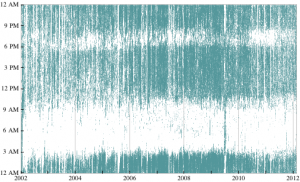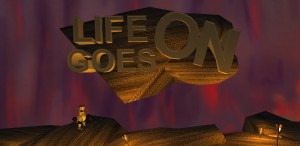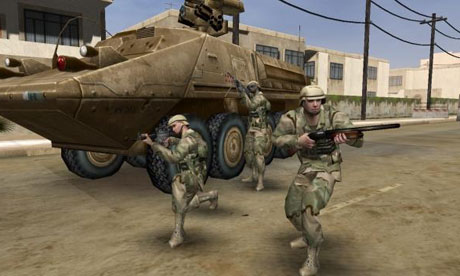Sinead introduced me to a cool crowdsourcing game from the National Library of Finland called Digitalkoot. As your proof words from the OCRing of 19th century newspapers you create bridges for moles. The YouTube above shows the game. The company behind this will apparently build and run a game like this for you for a fee.
Near Futures for the Digital Humanities
On Friday I went down to Cork to give a talk on Near Futures for the Digital Humanities at University Collge Cork (Ireland). UCC is one of the universities that are offering the Structured PhD in Digital Arts and Humanities (DAH) so I had a chance after the talk to learn about the program and how it is developing.
The topic of my talk is one we all love to speculate about but should also be careful about as predictions about the future are often so wrong (or so about us now.) I titled my talk “Near Futures” because I wanted to stick to what is near AND talk about how we get near to the future through imagining possibilities (and building possibilities.) The digital humanities has, I think, a different relationship with future humanities than other disciplines that are more focused on the past. That is not to say that other disciplines don’t imagine the future, it is just to say that the digital humanities has to navigate the tide of futurism in computing in general.
Luis von Ahn on reCaptcha and Duolingo
Patrizia pointed me to a TEDxCMU talk by Luis von Ahn on The Next Chapter in Human Computation. von Ahn is known for Captcha and reCaptcha (which he talks about in the first 8 minutes of the talk.) In this talk he introduces his team’s new crowdsourcing project duolingo which aims to translate the web while teaching people a second language. Instead of paying $500 for RosettaStone software you can learn a language by translating progressively more complex sentences from the web.
von Ahn also calls this a “Fair Business Model for Education”. (There is actually a slide with this phrase.) His argument is that since most of the world doesn’t have the money for software, duolingo presents a fair way for them to contribute labour in return for learning a language. I note that the fair business model could apply not just to language education, but other types of education. How could you monetize the teaching of philosophy (or ethics)? What would people do to learn that could also benefit someone else?
Life Goes On
David, one of the students I work with was involved in a Hackathon and Global Game Jam in Edmonton. The team he was on developed a very cool game idea called, Life Goes On. The idea was to make dying a game mechanic. You can now download the game now and try it.
Are video games just propaganda and training tools for the military? | Technology | The Guardian
The Guardian has a good story on Are video games just propaganda and training tools for the military?. Despite the title, the story doesn’t really take sides. It documents the variety of ways that game companies and armies interact from companies like Kuma Games that make Kuma\War games out of current events. The article also links to an interesting grant award to Kuma from the Department of Defense for game-based second language training:
Utilizing our tools, experience, and huge library of existing 3D assets we can provide an effective, cost-efficient, rapidly-deployable and easily updatable language retention toolset for trainers and Soldiers deployed around the world. It is our intention to refresh languages skills in an intense and immersive 3D environment, which would be made available as part of an online/offline language exercise portal …
The article also documents games made from an Arab perspective by companies in Syria, developers tied to the Hezbollah and Irani organizations. These games (whether the Kuma\War games or those from other perspectives) can be seen as soft propaganda – making normal attitudes about who is good and bad. Such games don’t train people the way simulators might, but they can recruit people or legitimize a cause.
One could argue that just as in the Cold War the “soft power” of American movies played a key role, so in the percieved conflict with terrorism software is playing a similar propaganda role. The problem may be that the wrong people are being portrayed as the bad guys. The propaganda on both sides may be too crude and may make reconciliation harder.
In the meantime Iran has sentenced one of the Kuma designers to death accusing him of developing for the CIA. The game gets serious for this poor designer who was detained when he visited family in Iran.
@MentionMachine: Who’s up, who’s down on Twitter?
Reading the Washington Post I was annoyed by a panel at the bottom of my screen with their @MentionMachine tracks the presidential candidates: Who’s up, who’s down on Twitter?. The @MentionMachine tracks Twitter mentions using the Twitter API and also media mentions using Trove. This is real-time social media text analysis. The Washington Post blog page on @MentionMachine argues that “Twitter was the real-time warning system” that could tell us which candidates were trending up or down. I wonder if that is reliably true or only true in selective cases.
Narrative and Technology: Curtis Wong and Geoffrey Rockwell in Conversation – YouTube
The kind folks at the Long Room Hub at Trinity College Dublin have put up the video of the “conversation” I participated in on the 6th of March. The event was called Narrative and Technology: Curtis Wong and Geoffrey Rockwell in Conversation. Curtin Wong is now at Microsoft Research, but worked for some time at the Voyager Company back in the days when they were developing some of the most interesting multimedia works.
IBM Sage Computer, 1960 from the Retronaut
Thanks to the Guardian I discovered the Retronaut, a site dedicated to past visions including past visions of the future. They have a number of interesting things like a video of the IBM Sage Computer, 1960 or Video Games Then and Now. There is a prescient Telecommunications Services for the 1990s created in 1969 for the Post Office Research Station of the UK in 1969.
Stephen Wolfram Blog : The Personal Analytics of My Life
 Thanks to Bethany on twitter I came across this great post by Stephen Wolfram on The Personal Analytics of My Life. Wolfram is not the first person to use computers to track his activities and then understand himself. Microsoft Research has a project MyLifeBits that is “an attempt to fulfill Vannevar Bush‘s vision of an automated store of the documents, pictures (including those taken automatically), and sounds an individual has experienced in his lifetime, to be accessed with speed and ease.” The project is digitizing and following Gordon Bell and they have released a book Your Life, Uploaded. We could even go back to the ancient Greek aphorism “Know theyself” that motivated Socrates and which, in its Latin form (temet nosce), shows up over the door of the Oracle in the Matrix.
Thanks to Bethany on twitter I came across this great post by Stephen Wolfram on The Personal Analytics of My Life. Wolfram is not the first person to use computers to track his activities and then understand himself. Microsoft Research has a project MyLifeBits that is “an attempt to fulfill Vannevar Bush‘s vision of an automated store of the documents, pictures (including those taken automatically), and sounds an individual has experienced in his lifetime, to be accessed with speed and ease.” The project is digitizing and following Gordon Bell and they have released a book Your Life, Uploaded. We could even go back to the ancient Greek aphorism “Know theyself” that motivated Socrates and which, in its Latin form (temet nosce), shows up over the door of the Oracle in the Matrix.
Continue reading Stephen Wolfram Blog : The Personal Analytics of My Life
Interview with doujinshi creator
While I was in Japan I had the good fortune to meet a number of people who were involved in the creation of fan circle or doujin manga, anime and games. These circles and the often very professional fan works they publish are a phenomenon that is important to understanding Japanese popular culture so I asked one if I could interview her about her experience. The interview was conducted over email in December of 2011, January and Februrary of 2012. I sent her questions, she sent back answers, and I edited them into this dialogue which she then checked and added to. In my editing I tried to keep her distinctive voice, but did edit for grammar where confident in her meaning. In some cases I have added explanations that are [in brackets and italicized.] I have kept her identity secret at her request.


